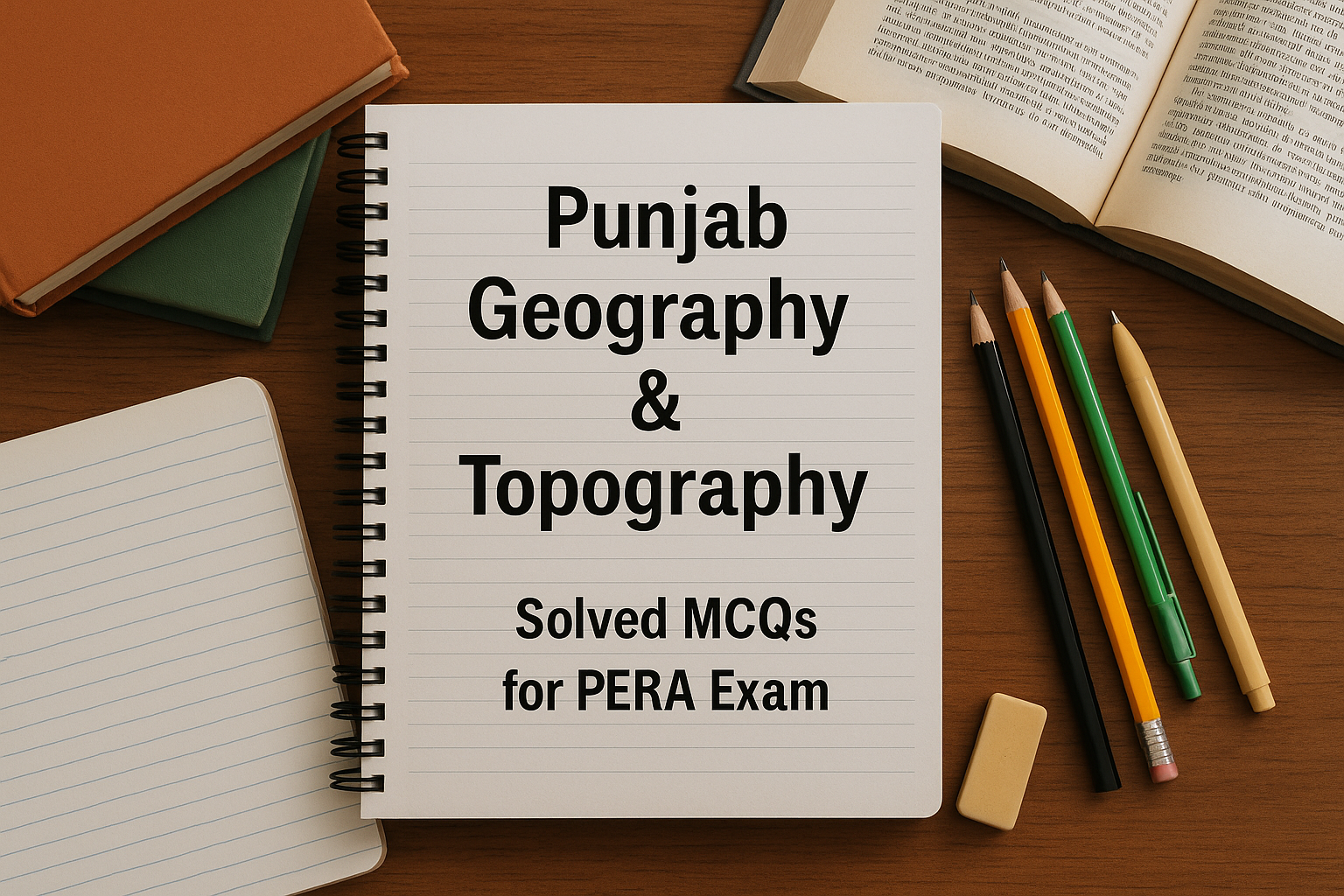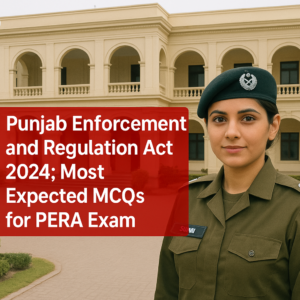- Punjab is located in the eastern part of Pakistan.
- The word “Punjab” means land of five rivers.
- Punjab shares its eastern boundary with India.
- Punjab borders Khyber Pakhtunkhwa in the northwest.
- Punjab borders Balochistan in the southwest.
- Punjab borders Sindh in the south.
- Punjab borders Islamabad Capital Territory in the north.
- The total area of Punjab is about 205,344 square kilometers.
- Punjab is the second largest province of Pakistan by area.
- Punjab is the most populous province of Pakistan.
- The northern boundary of Punjab touches the Himalayas.
- Punjab’s boundary with India lies along the Radcliffe Line.
- Punjab shares an international boundary with Indian Punjab.
- The Ravi River flows along the eastern border with India.
- The Sutlej River also runs near the border with India.
- Punjab’s capital city is Lahore.
- Punjab lies between latitude 27°–37° North.
- Punjab lies between longitude 69°–75° East.
- Punjab has a continental type of location.
- Punjab connects the north and south of Pakistan.
- Punjab is the gateway to Kashmir from Pakistan.
- Punjab lies in the Indo-Gangetic plain.
- Punjab is situated mainly on the alluvial plains of the Indus River system.
- Punjab shares its northern boundary with Azad Jammu and Kashmir.
- The name “Punjab” was derived from Persian words Panj (five) and Aab (water).
- The five rivers of Punjab are Jhelum, Chenab, Ravi, Sutlej, Beas.
- Out of the five rivers, Beas lies entirely in India.
- Punjab forms about 25% of Pakistan’s total land area.
- Punjab is strategically located at the crossroads of South Asia and Central Asia.
- The location of Punjab makes it the heartland of Pakistan.
- The topography of Punjab is mostly alluvial plains.
- Punjab’s plain is part of the Indus River Basin.
- Punjab has two main regions: upland areas and lowland plains.
- The Pothohar Plateau lies in northern Punjab.
- The Salt Range is located south of the Pothohar Plateau.
- The highest peak in the Salt Range is Sakesar (1,522 m).
- The Salt Range is rich in rock salt deposits.
- Soan River flows through the Pothohar Plateau.
- The Thal Desert lies between the Jhelum and Indus rivers.
- The Cholistan Desert lies near the Sutlej River in southern Punjab.
- Cholistan Desert is also called Rohi.
- The Cholistan Desert covers about 26,300 sq km.
- The Ravi, Chenab, Jhelum, and Sutlej are the main rivers flowing through Punjab.
- Indus River flows along the western boundary of Punjab.
- The Pothohar Plateau is known for ravines and uneven surface.
- Khewra Salt Mines are located in the Salt Range, Punjab.
- The Salt Range is famous for its fossil remains of prehistoric animals.
- The Bari Doab lies between Ravi and Sutlej rivers.
- The Rechna Doab lies between Ravi and Chenab rivers.
- The Chaj Doab lies between Chenab and Jhelum rivers.
- The Sindh Sagar Doab lies between Jhelum and Indus rivers.
- The word “Doab” means land between two rivers.
- The Thal Desert is mainly a sand dune desert.
- The Cholistan Desert extends into Rajasthan Desert (India).
- The Pothohar Plateau is the oldest geological formation in Punjab.
- Attock district lies at the northwestern tip of Punjab.
- Punjab’s terrain becomes more arid and sandy towards the south.
- The Pabbi Hills are located in northern Punjab.
- The Kala Chitta Range is located near Attock.
- The Margalla Hills touch the north of Punjab near Islamabad.
- Punjab’s plain is formed by deposition of alluvium by rivers.
- The Salt Range separates the Pothohar Plateau from the Punjab Plain.
- The Thal Desert lies mainly in Bhakkar, Khushab, Layyah, and Jhang districts.
- The Cholistan Desert lies mainly in Bahawalpur district.
- The Pothohar Plateau is bounded by Jhelum River in the east and Indus River in the west.
- The Sakesar peak is also a site of Pakistan Air Force radar station.
- The Punjab plain is part of the Great Indo-Gangetic plain.
- Tilla Jogian is the highest peak of Jhelum district.
- The Bara Pahar mountain is part of Salt Range.
- Punjab’s landform shows a gradual slope from northeast to southwest.
- The climate of Punjab is generally continental.
- Punjab experiences extreme summer and winter.
- The hottest months in Punjab are May, June, and July.
- The coldest months in Punjab are December and January.
- The summer temperature in Punjab often rises above 45°C.
- The winter temperature in Punjab may fall below 0°C.
- The average annual rainfall in Punjab is about 300–700 mm.
- Rainfall is higher in the north and lower in the south of Punjab.
- The Monsoon season in Punjab lasts from July to September.
- Punjab receives most of its rainfall from the Southwest Monsoon.
- The northern Punjab (e.g., Murree) has humid subtropical climate.
- Southern Punjab (e.g., Bahawalpur) has arid desert climate.
- The Pothohar Plateau experiences semi-arid climate.
- The hottest place in Punjab is often Multan and Bahawalpur region.
- The coolest place in Punjab is Murree.
- The average temperature of Murree in summer is around 20°C.
- The average temperature of Multan in summer can reach over 42°C.
- The rainfall in Murree averages around 1,700 mm annually.
- Dust storms are common in southern Punjab during summer.
- The Loo (hot winds) blow in Punjab during May and June.
- Winter rainfall in Punjab is caused by Western Disturbances.
- Punjab has four distinct seasons: summer, monsoon, winter, and spring.
- Spring season in Punjab is observed in March and April.
- Fog is common in Punjab during December and January.
- Murree receives heavy snowfall in winter.
- The monsoon rains are vital for agriculture in Punjab.
- The southern Punjab often faces drought conditions.
- Average rainfall in southern Punjab (Bahawalpur, Cholistan) is less than 200 mm.
- Northern Punjab is prone to flash floods during monsoon.
- The climate of Punjab is influenced by Himalayan mountains and Thar Desert.
- The average annual temperature of Punjab is around 24°C.
- Punjab’s weather patterns are highly seasonal and irregular.
- Heat waves often strike Punjab in late May and early June.
- Climate change is causing longer summers and erratic monsoons in Punjab.
- Northern Punjab enjoys relatively pleasant climate compared to southern Punjab.
- The soil of Punjab is mostly alluvial.
- Alluvial soil in Punjab is deposited by the Indus river system.
- Punjab’s alluvial soil is very fertile.
- The soil in Pothohar Plateau is gravelly and less fertile.
- The Thal Desert has mostly sandy soil.
- The Cholistan Desert has arid sandy soil.
- Punjab’s soil is ideal for wheat and rice cultivation.
- The soil of central Punjab is suitable for sugarcane.
- Loamy soil is common in upper Punjab plains.
- Punjab soil needs irrigation due to low rainfall in many areas.
- Punjab is called the “breadbasket of Pakistan” because of its fertile soil.
- The main vegetation type in Punjab is dry tropical thorn forest.
- Natural vegetation has been largely replaced by cultivated crops.
- Shisham (Dalbergia sissoo) is a common tree in Punjab.
- Acacia (Kikar) trees are common in dry areas of Punjab.
- The Cholistan Desert has mostly scrub vegetation.
- The Thal Desert is covered with sparse bushes and grasses.
- Irrigated plantations have been established in Changa Manga and Chichawatni.
- Changa Manga forest is the largest man-made forest in Pakistan.
- Major forest types in Punjab include riverine, scrub, and irrigated forests.
- Riverine forests grow along the Indus and its tributaries.
- Scrub forests are found in Pothohar and Salt Range.
- Irrigated plantations are found in canal-irrigated regions of Punjab.
- Mulberry trees are common in Punjab and support the silk industry.
- The Shalamar Gardens of Lahore historically had dense plantation of fruit trees.
- Forests in Punjab cover about 3% of the province’s area.
- The forests provide timber, fuelwood, and fodder.
- The natural vegetation of Punjab has declined due to urbanization and agriculture.
- Mango orchards are common in Multan, Bahawalpur, and Muzaffargarh.
- Citrus orchards are common in Sargodha district.
- Punjab is the agricultural heartland of Pakistan.
- Punjab contributes about 70% of Pakistan’s total agricultural output.
- The main food crop of Punjab is wheat.
- Punjab produces the largest share of Pakistan’s wheat.
- Rice is the second major food crop of Punjab.
- Basmati rice of Punjab is famous for its aroma and export quality.
- Punjab contributes about 80% of Pakistan’s rice production.
- The main cash crop of Punjab is cotton.
- Cotton is grown mainly in southern Punjab.
- Sugarcane is a major industrial crop of Punjab.
- Sugarcane supports the sugar industry in Punjab.
- Maize is widely cultivated in central Punjab.
- Barley is grown in dry areas of Punjab.
- Oilseed crops in Punjab include sunflower and mustard.
- Punjab is famous for citrus fruits, especially kinnow.
- Sargodha is called the “California of Pakistan” due to citrus orchards.
- Mangoes are mainly produced in Multan and Bahawalpur regions.
- Punjab also grows guava, pomegranate, and dates.
- Punjab is a major producer of vegetables like potatoes, onions, and tomatoes.
- Punjab produces the majority of milk and dairy products in Pakistan.
- Livestock in Punjab includes buffaloes, cows, goats, and sheep.
- Punjab provides over 60% of Pakistan’s livestock population.
- The Indus Basin Irrigation System supports Punjab’s agriculture.
- Punjab has one of the largest canal irrigation networks in the world.
- Important barrages in Punjab include Jinnah, Chashma, and Trimmu.
- The Mangla Dam (in AJK but supplying Punjab) irrigates large areas of Punjab.
- The major natural resource of Punjab is fertile soil.
- Punjab is rich in minerals such as rock salt, gypsum, and coal.
- The Khewra Salt Mine is the second largest salt mine in the world.
- The Salt Range also contains gypsum, limestone, and dolomite.
- Coal is mined in Makarwal and Dandot areas of Punjab.
- Punjab also has reserves of iron ore and silica sand.
- The forests of Punjab provide wood, honey, and medicinal herbs.
- The rivers of Punjab are a source of freshwater fish.
- Major fish farms are located in Kasur and Sheikhupura districts.
- Punjab contributes to Pakistan’s textile industry through cotton.
- Agriculture is the backbone of Punjab’s rural economy.
- Canal colonies were established in Punjab during British rule.
- Punjab’s agricultural success depends on irrigation water availability.
- Over-irrigation in Punjab has caused problems of waterlogging and salinity.
- Punjab is the most populous province of Pakistan.
- Punjab holds about 53% of Pakistan’s total population.
- The population of Punjab is over 110 million (2017 Census).
- The population density of Punjab is about 536 persons per sq km.
- Lahore is the largest city of Punjab.
- Lahore is the second-largest city of Pakistan after Karachi.
- Other major cities of Punjab include Faisalabad, Rawalpindi, Multan, and Gujranwala.
- Faisalabad is called the Manchester of Pakistan due to textiles.
- Multan is called the City of Saints.
- Gujranwala is known as the City of Wrestlers.
- Sialkot is famous for sports goods and surgical instruments.
- The literacy rate of Punjab is about 66% (2017 Census).
- Male literacy in Punjab is higher than female literacy.
- The major ethnic group in Punjab is Punjabi.
- The main language spoken in Punjab is Punjabi.
- The official language of Punjab is Urdu.
- Other languages spoken in Punjab include Saraiki and Pothohari.
- Islam is the religion of more than 97% of Punjab’s population.
- Minorities in Punjab include Christians, Hindus, and Sikhs.
- Punjab is the most urbanized province after Sindh.
- About 37% of Punjab’s population lives in urban areas.
- The sex ratio in Punjab is about 106 males for every 100 females.
- The economy of Punjab is mainly agrarian.
- Punjab contributes more than 50% to Pakistan’s GDP.
- Punjab is the industrial hub of Pakistan after Karachi.
- Lahore is the cultural and economic center of Punjab.
- Faisalabad is a major industrial and textile center.
- Punjab’s industries include textiles, sugar, cement, and fertilizers.
- Sialkot produces world-class footballs and surgical instruments.
- Gujrat and Wazirabad are famous for cutlery and pottery.
- The unemployment rate in Punjab is lower than in other provinces.
- Punjab has a large middle class compared to other provinces.
- Punjab is also a major center of trade and transport in Pakistan.
- The road and rail networks of Punjab connect it with all provinces.
- Punjab’s economy is supported by overseas remittances as well.
- Punjab faces serious issues of air pollution and smog.
- Lahore is among the most polluted cities in the world.
- Smog in Punjab is caused by vehicular emissions, crop burning, and industry.
- Smog season in Punjab starts in October and lasts till January.
- Deforestation is a major environmental problem in Punjab.
- Forest cover in Punjab is less than 3% of its total area.
- Rapid urbanization has reduced agricultural and forest land.
- Punjab suffers from waterlogging and salinity due to over-irrigation.
- Waterlogging affects crop yield in southern Punjab.
- Industrial waste pollutes rivers, especially Ravi River.
- The Ravi River is considered the most polluted river in Punjab.
- Solid waste management is a growing challenge in major cities of Punjab.
- Lahore generates over 6,000 tons of solid waste daily.
- Noise pollution is increasing in urban Punjab.
- Punjab faces frequent floods during the monsoon season.
- Flash floods are common in northern Punjab (Pothohar Plateau).
- Drought is common in southern Punjab (Cholistan and Thal).
- Climate change has intensified heat waves in Punjab
- Vehicular traffic is the largest contributor to air pollution in Punjab’s cities.
- Punjab has established the Environment Protection Department (EPD).
- Green Pakistan Program was launched to promote afforestation in Punjab.
- Lahore, Faisalabad, and Gujranwala face severe urban pollution.
- Punjab also faces the problem of groundwater depletion.
- Use of untreated water for irrigation causes soil contamination.
- Punjab needs sustainable development policies to handle environmental challenge.
📍 English Language Educator | Blogger & Content Strategist | 7+ Years in Educational Blogging
Nosheen Bashir is a dedicated English teacher and experienced blogger with over seven years of expertise in content creation and educational writing. Passionate about language, literature, and effective communication, she combines her teaching experience with blogging skills to create insightful, research-backed content that helps learners and educators alike.
🔹 Expertise & Achievements:
✔ English Language Education: A skilled educator with years of experience in teaching English grammar, literature, and communication skills to students of varying levels.
✔ Educational Blogging: Running a successful blog for 7+ years, delivering well-structured, engaging content on language learning, writing techniques, and academic success.
✔ SEO & Content Strategy: Specializes in creating high-ranking, authoritative articles that follow Google’s EEAT principles, ensuring content that is both informative and search-friendly.
✔ Student-Centric Approach: Committed to making English easier, engaging, and accessible, helping readers and students improve their language proficiency.
🚀 With a passion for teaching and writing, Nosheen Bashir is dedicated to crafting educational content that empowers students, teachers, and language enthusiasts worldwide.







